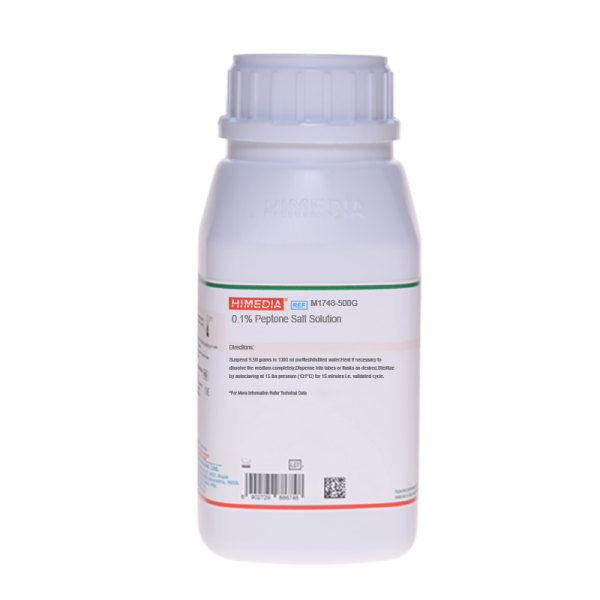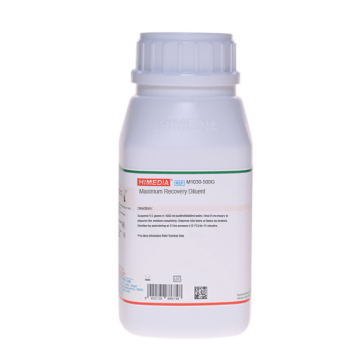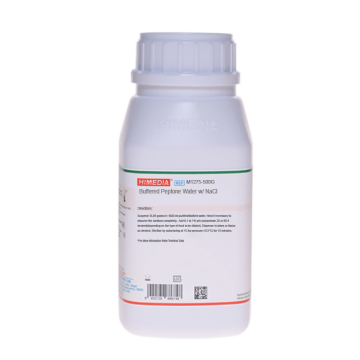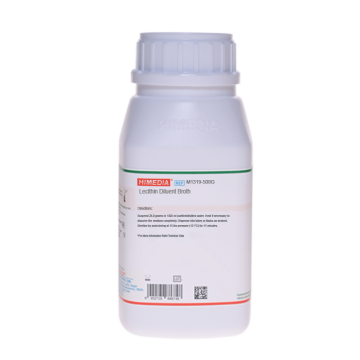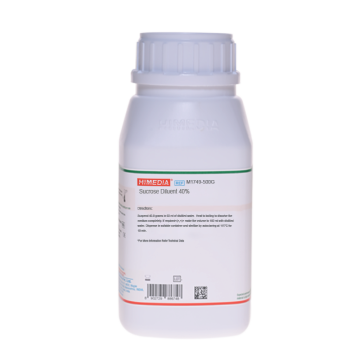 Your enquiry has been submitted
Your enquiry has been submitted
0.1% Peptone Salt Solution
Intended use
Recommended as diluent for different test method
Composition**
| Ingredients | Gms / Litre |
|---|---|
| Peptone | 1.000 |
| Sodium chloride | 8.500 |
Final pH ( at 25°C): 7.0±0.2
**Formula adjusted, standardized to suit performance parameters
Directions
Suspend 9.50 grams in 1000 ml purified / distilled water. Heat if necessary to dissolve the medium completely. Dispense into tubes or flasks as desired. Sterilize by autoclaving at 15 lbs pressure (121°C) for 15 minutes i.e. validated cycle.
Principle And Interpretation
0.1% Peptone Salt solution is recommended as a diluent for dilution of sample by different test methods widely used for examination of foodstuffs. Standard methods for the examination of foodstuffs require sample dilution to be carried out accurately for enumerating the microorganisms. This medium is also recommended by ISO Committee (1) for use as an isotonic diluent.
It contains peptone at low concentration which provides nutrients for survival of microorganisms and hence protecting the organisms (2). Sodium chloride at 0.85% concentration maintains osmotic balance of medium thereby maintaining cell morphology and integrity (3). The pH of this diluent medium is near neutral range optimum for viability of microorganisms. Therefore it can be successfully used as a diluent for carrying out dilutions of different samples.
It is recommended to use 10 gm of test sample along with 90 ml of 0.1% Peptone salt solution for enumeration. The prepared dilution may be blended at 15,000 to 20,000 revolutions per minute. Further a ten fold dilution may be prepared using 1 ml of it in 9ml of sterile diluent within 15 minutes and mixed well. This is considered as 10-1 dilution. Sequential dilutions can be prepared using same diluent and counts obtained by spread plate or pour plate technique. Tests may be performed in duplicates as described in technique and checked for equivalent yields of organisms between the diluent batches.
Incubate the tubes with test organisms. At time of zero minutes and after 30 minutes and 2 hours, subculture an inoculum (approximately 0.01ml) or a loop full onto Soyabean Casein Digest Agar (M290) using streak plate technique. If desired SCDA may be also enriched with 5% v/v sheep blood depending on intended organisms to be isolated. Incubate plates at 35 ±2ºC for 18-24 hours.
Type of specimen
Food and dairy samples; Water samples
Specimen Collection and Handling
For food and dairy samples, follow appropriate techniques for sample collection and processing as per guidelines (4,5,6). For water samples, follow appropriate techniques for sample collection and processing as per guidelines (7).
After use, contaminated materials must be sterilized by autoclaving before discarding.
Warning and Precautions
Read the label before opening the container. Wear protective gloves/protective clothing/eye protection/ face protection. Follow good microbiological lab practices while handling specimens and culture. Standard precautions as per established guidelines should be followed while handling specimens. Safety guidelines may be referred in individual safety data sheets.
Limitations
- This medium is general purpose medium and may not support the growth of fastidious organisms.
- Some strains may show poor growth due to nutritional variations.
- Further serological and biochemical testing is required for complete identification.
Performance and Evaluation
Performance of the medium is expected when used as per the direction on the label within the expiry period when stored at recommended temperature.
Quality Control
Appearance: Off white to yellow homogeneous free flowing powder
Colour and Clarity of prepared medium: Cream to pale yellow clear solution in tubes
Reaction: Reaction of 0.95% w/v aqueous solution at 25°C. pH : 7.0±0.2
pH: 6.80-7.20
Cultural Response: Cultural characteristics observed on Soyabean Casein Digest Agar (M290), after an incubation at 35-37°C for 18-48 hours of cultures suspended in 0.1% Peptone Salt solution for 30 minutes.
| Organism | Inoculum (CFU) | Recovery (after 30 minutes) |
|---|---|---|
| Escherichia coli ATCC 25922 (00013*) | 50-100 | no change in numbers |
| Staphylococcus aureus subsp. aureus ATCC 25923 (00034*) | 50-100 | no change in numbers |
Key : (*) Corresponding WDCM numbers.
Storage and Shelf Life
Store between 10-30°C in a tightly closed container and the prepared medium at 15-25°C. Use before expiry date on the label. On opening, product should be properly stored dry, after tightly capping the bottle inorder to prevent lump formation due to the hygroscopic nature of the product. Improper storage of the product may lead to lump formation. Store in dry ventilated area protected from extremes of temperature and sources of ignition. Seal the container tightly after use. Product performance is best if used within stated expiry period.
Disposal
User must ensure safe disposal by autoclaving and/or incineration of used or unusable preparations of this product. Follow established laboratory procedures in disposing of infectious materials and material that comes into contact with sample must be decontaminated and disposed of in accordance with current laboratory techniques (8,9).
Reference
- International Organization for Standardization (ISO),ISO/DIS 6649.
- Straker R.P.and Stokes J.L., 1957,Appl.Microbiol.,5:21.
- Patterson J.W. and Cassells J.A., 1963,J.Appl.Bacteriol., 26:493.
- American Public Health Association, Standard Methods for the Examination of Dairy Products, 1978, 14th Ed., Washington D.C.
- Salfinger Y., and Tortorello M.L. Fifth (Ed.), 2015, Compendium of Methods for the Microbiological Examination of Foods, 5th Ed., American Public Health Association, Washington, D.C.
- Wehr H. M. and Frank J. H., 2004, Standard Methods for the Microbiological Examination of Dairy Products, 17th Ed., APHA Inc., Washington, D.C.
- Baird R.B., Eaton A.D., and Rice E.W., (Eds.), 2015, Standard Methods for the Examination of Water and Wastewater, 23rd ed., APHA, Washington, D.C.
- Isenberg, H.D. Clinical Microbiology Procedures Handbook 2nd Edition.
- Jorgensen, J.H., Pfaller, M.A., Carroll, K.C., Funke, G., Landry, M.L., Richter, S.S and Warnock., D.W. (2015) Manual of Clinical Microbiology, 11th Edition. Vol. 1.
| Product Name | 0.1% Peptone Salt Solution |
|---|---|
| SKU | M1748 |
| Product Type | Regular |
| Physical Form | Powder |
| Origin | Animal |
| Packaging type | HDPE |
| References | 1.International Organization for Standardization (ISO),ISO/DIS 6649.2.Straker R.P.and Stokes J.L., 1957,Appl.Microbiol.,5:21.3.Patterson J.W. and Cassells J.A., 1963,J.Appl.Bacteriol., 26:493. |
| Customized Product Available | No |



